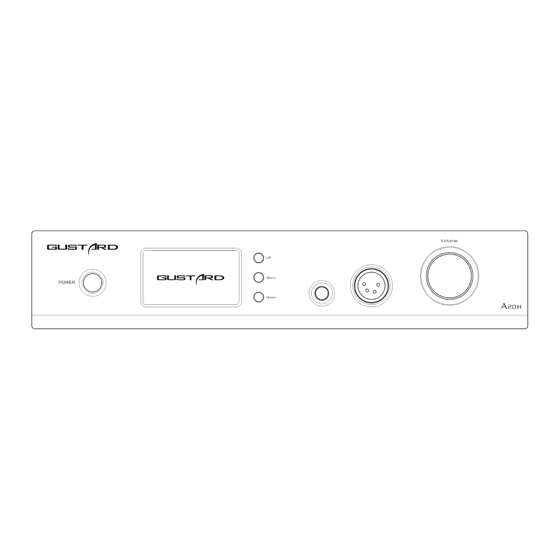
Table of Contents
Advertisement
Advertisement
Table of Contents

Summary of Contents for GUSTARD A20H
- Page 1 Gustard DAC/Headphones Amplifier User Manual...
-
Page 2: Table Of Contents
Table of Contents Front Panel..............2 Rear panel............... 2 The Screen and the Setting menu..........3 Remote controller............... 5 Product Specification............6 Warranty and service............7 Drivers installation.............. 8 OS Settings..............11 Archive DSD function with foobar2000........12 Q/A................16 - 1 -... -
Page 3: Front Panel
Front panel 1. The Power button is a key switch, press once to power on, press again to shutdown. 2. The screen shows the current input channel, encoding format, and sample rate, volume and other status. 3. The Function buttons can be used to select the input channel and enter the settings menu. 4. -
Page 4: The Screen And The Setting Menu
2.Input channel selection The A20H has 5 input channels. In main menu status, press button "Down" could select in COAX——AES——USB——IIS——OPT. You can also press "Up" to select in the Reverse order. - Page 5 5.Menu Function Introduction In main menu status, press the Menu button to enter the setting menu. The following is a line-by-line introduction. a. PCM FILTER: The filter can work in six modes: SHARP——SLOW——SUPER SLOW——SHORT SHARP——LOW-d SHORT——SHORT SLOW. Switched by the Volume knob. SHARP for rapid roll-off digital filtering, the most common type of digital filters, listening to the sense of the most accurate, neutral;...
-
Page 6: Remote Controller
⑤ Volume Decrease Button: It can reduce volume only if A20H shows the main menu on the screen. ⑥ Volume Increase Button: It can increase volume only if A20H shows the main menu on the screen. ⑦ Mute Button: A20H will be muted when this button is pressed once. And mute will be released after another pressing. -
Page 7: Product Specification
Product Specifications Digital Input COAX input format supported: PCM 16-24bit/44.1-192kHz; DSD DOP64 BNC input format supported: PCM 16-24bit/44.1-192kHz; DSD DOP64 AES input format supported: PCM 16-24bit/44.1-192kHz; DSD DOP64 OPT input format supported: PCM 16-24bit/44.1-192kHz; DSD DOP64 USB input format supported: PCM 16-32bit/44.1-384kHz;... -
Page 8: Warranty And Service
Free Warranty Service GUSTARD A20H from the purchasing date in the free warranty period, the user uses the product in normal, and the product fails due to component quality or manufacturing problems. -
Page 9: Drivers Installation
USB Driver Installation Under Windows * XMOS USB driver can be found in the CD-ROM accessory or USB disk. Also one can visit the official website http://www.gustard.cn for downloading the driver as well. * Windows 10 users must disable digital signature before installing the driver, or it might be installed unsuccessful. - Page 10 4. Following the prompts, then click next to install. 5. Checking system status. If showing red text prompts “Setup requires that the device is...”, please restart DAC-X20 or reconnect the USB cable. - 9 -...
- Page 11 6. If a security warning pops up, you can just ignore it by clicking "Install this driver software anyway", and then complete the driver installation. 7. Here shows the screen of a successful driver installation. Clicking “Finish” button to complete the installation。 - 10 -...
-
Page 12: Os Settings
◆ Setting DAC-X20(XMOS XS1-U8 MFA) as the default system playback device Finding the speaker icon at the lower right corner of the windows desktop, right-clicking, and then clicking the menu item "Playback Devices". Selecting "XMOS XS1-U8 FMA (ST)", and clicking on the bottom "Set to the Default Value", and setting the maximum system volume。... -
Page 13: Archive Dsd Function With Foobar2000
◆ Setting DAC-X20 as Common Output Playback Device ● Configuration in foobar2000 Clicking File->Preferences Clicking Playback->Output, selecting“ASIO:XMOS USB Audio 2.0 ST 3033” on the drop-down menu from “Device”. - 12 -... - Page 14 ◆ Archiving DSD hardware decoding by most common play-back application ● Setting in foobar2000 1. Opening folder “ASIO Proxy for Foobar2000” , double clicking “ASIOProxyInstall -0.7.1.2.exe” icon, and clicking “next” for finishing installation. Pressing combination keys “Ctrl+P” under the main screen of foorbar2000. Showing up “Preferences” dialog box. Finding “foo_dsd_asio”...
- Page 15 Clicking Playback->Output. From “Device”drop-down menu, selecting “ASIO:foo_dsd_asio”. Clicking Tools->SACD. From “Output Mode” drop-down menu, selecting “DSD”. Clicking “OK” for finishing all settings. Making sure the playback volume of XMOS is the maximum value, otherwise, nothing can be heard. - 14 -...
- Page 16 Problem and Solution for DSD playback ● For using foobar2000 application 1. Why there is no “ASIO” under the path “Playback->Output” in “Preferences” dialog box? Solution: The main reason is no ASIO component installation. Opening folder “foobar2000 Components” and dragging file “foo_out_asio.fb2k-component”...
-
Page 17: Q/A
3. Why there is no sound when playing DSD64/DSD128 music file, but the LCD still displays “176.4K/352.8K” message? Solution: Because the system volume of XMOS USB AUDIO device is not set to 100%. The DSD identification code encoded in DoP carriers is destroyed by the system volume control function. Finding the speaker icon at the lower right corner of the windows desktop, right-clicking, and then clicking the menu item "Playback Device (P)". - Page 18 Some users are using an older version of foobar2000, its SACD decoding component ID is starts from 0.6.X. If you install ASIOProxyInstall-0.7.1.2.exe program, then foo_dsd_asio version is 0.7.1.2, and components conflict happens. Solutions: To solve the above problem, there are two solutions in totals. The first solution is to update the SACD component, as the methods described in Question 2.




Need help?
Do you have a question about the A20H and is the answer not in the manual?
Questions and answers